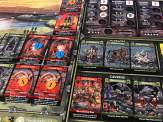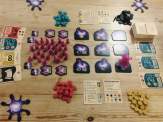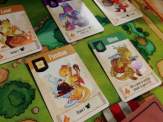| Release Date: 2023 | Players: 1-4 |
| Designer: James Faulkner, Paul D. Allen | Length: 15-45 minutes |
| Artist: Imad Awan, Raben White | Age: 12+ |
| Publisher: Lucky Duck Games | Complexity: 2.5 / 5 |
| Plastic (by weight): 25% | Air (by volume): 25% |
Feudal Japan is in turmoil. The collapse of the ancient authority of the Ashikaga Shogunate has plunged the country into a brutal civil war, known to history as the Sengoku Jidai. Clans clash in a relentless struggle for power and prestige. Now it is your turn to enter this bloody conflict as a great warrior. This is Senjutsu: Battle for Japan by Paul D. Allen and James Faulkner from Lucky Duck Games with illustrations from Imad Awan and Raben White.
Listen to the Audio Version
Intro Music: Bomber (Sting) by Riot (https://www.
Music by Bensound
License code: XEIX6AY2E5AOGZOR
Music: “Legend” by AShamaluevMusic.
Website: https://www.
Massive Battles on a Small Scale
I have always been fascinated by tabletop skirmish games. Moving little warriors around to engage in small fights or massive battles can be very comforting, as it takes me back to my childhood. Now, I’m not saying that modern miniature war games such as Warhammer are child’s play – far from it. There are many dedicated enthusiasts who spend days assembling plastic figures and painting them with aplomb to create stunning effects. When the models are added to painstakingly created dioramas, the resulting scene is visually awe-inspiring.
However, I never had the time, or money, to play my part in the miniature skirmish game hobby, as much as I am still fascinated by it. So finding a game that allows me to get a sense of how it might feel to fight with others, without having to spend many an evening working on the figures or learning the rules, is a delight.
Senjutsu: Battle for Japan is, of course, not the first tabletop skirmish game in a board game format. Games Workshop‘s Warhammer Underworlds series is probably better known in the hobby, but it is limited to 1-v-1 battles. Senjutsu has the advantage that you can play it solo or with up to 4 players. The board is also modular, which allows you to set up your little skirmish arena in different ways.
Now, I’m not going to spend the rest of the article comparing Senjutsu to Underworlds. Instead, I’m going to focus on how the former re-sparked my interest in tabletop skirmish games.
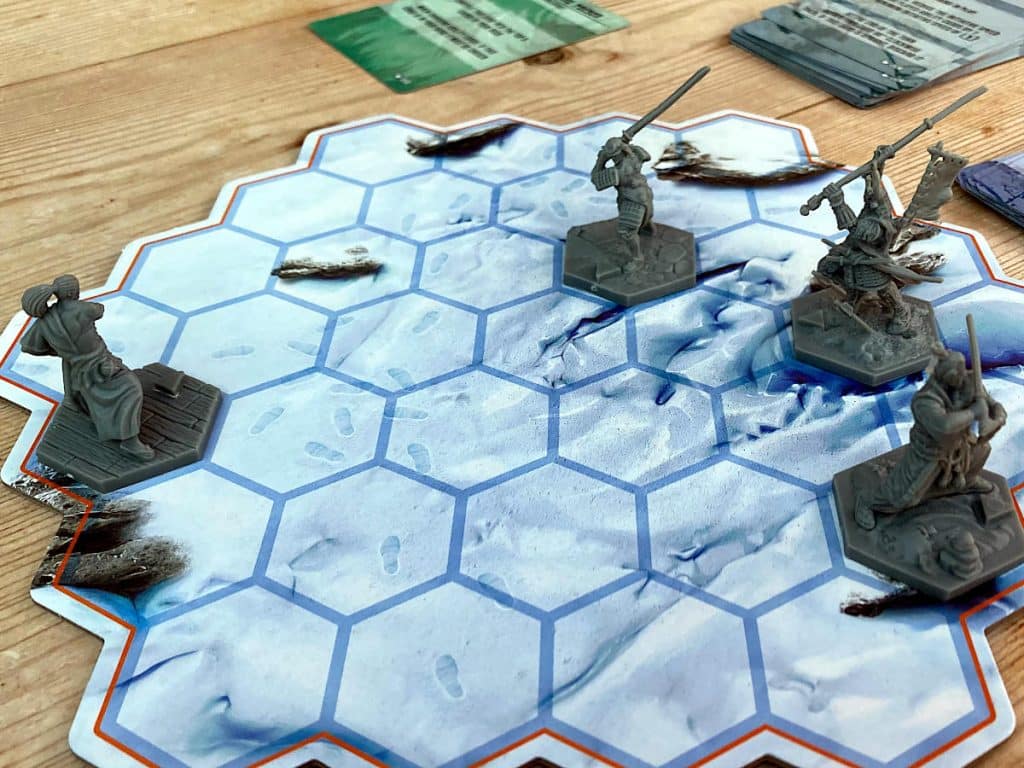
Battle in a Box
What makes Senjutsu: Battle for Japan so appealing for traditional board gamers is that you get everything in the box and how you play feels very familiar. There are no distance measuring tools, difficult line-of-sight rules or vertical positioning questions to deal with. Instead, there is a modular board divided into traditional hexes that make up the battle arena, which you can set up in different ways to create different scenarios.
Everyone also gets a lovely little miniature, which you can paint of course, if that scratches an itch. It is placed on one of the hexes and you move it from hex to hex, based on how much movement you have. The way your attack works is also based on the hexes. Just follow the diagram on your attack card to work out which enemy figure is your target.
The familiarity for traditional board gamers continues, because, at its core, Senjutsu: Battle for Japan is a card-driven game. The base game comes with 4 characters, each with their own unique decks. So every character plays differently and it is up to you to learn and understand your character’s unique deck to identify powerful combos that allow you to tease out the best of your fighter.
The game comes with pre-built decks, but there are additional cards and rules that allow you to customize them to better suit your style or to try out certain strategies. However, if, like me, you just want to start fighting, the starting decks are the best choice. They work really well and give you plenty to play with.
All Hands on Decks
The only thing that might be new to board gamers is the concept of initiative. Every round, all players choose a card from their hand and place it face-down in front of them. Once everyone is ready, the cards are revealed and the player who played the card with the highest initiative value goes first. Then the player with the next highest initiative takes their turn and so on, until everyone has activated their character. However, it’s not a difficult concept to grasp and will quickly make sense.
The layout of the cards themselves can feel a little overwhelming, but the rulebook has a quick symbol guide on the back to help you. In fact, the symbology in Senjutsu: Battle for Japan is really great and consistent. It might take a little while to learn all of the symbols, but it won’t take long and then it all flows quickly and is a lot better than long card text.
In fact, Senjutsu: Battle for Japan is fairly easy to learn. There are a handful of things that aren’t completely clear, but the publisher’s FAQs should help answer many of your questions. At the end of the day, if you don’t exactly know what to do in a certain situation and can’t quickly find it in the rulebook, house rule it and work it out later, just to keep the game going. So, yes, it shouldn’t take you long to get going and with the rulebook handy, your first game should already flow pretty well.
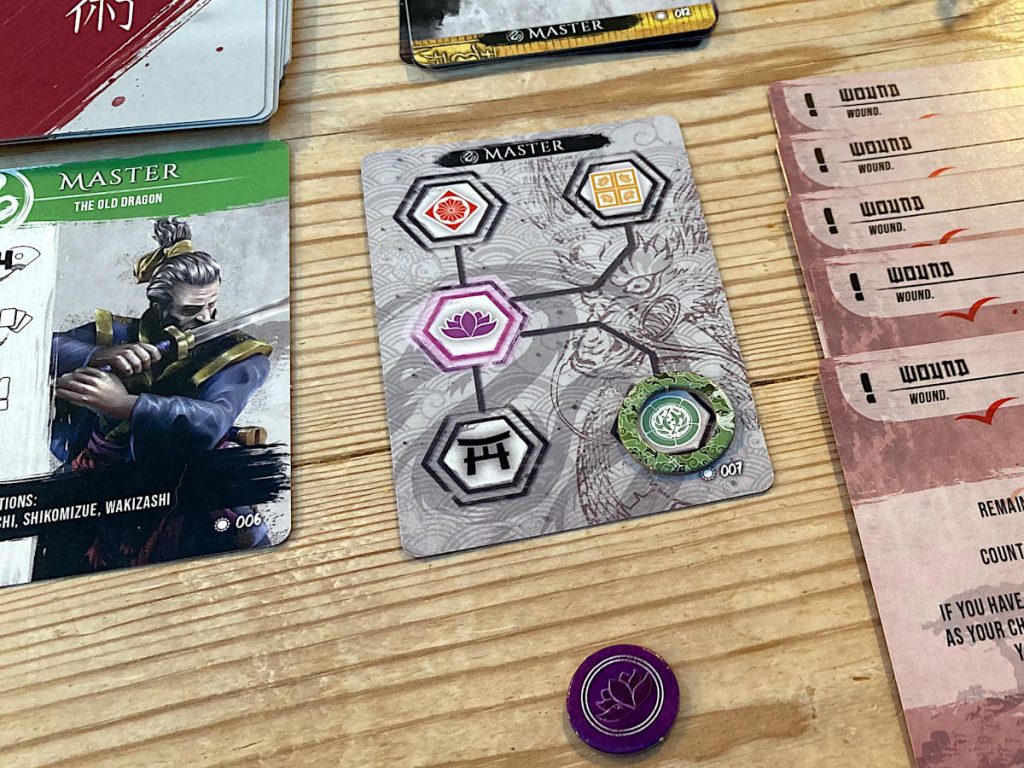
Face the Battle
Most of the game is about the cards, which usually give you a combination of movement or rotating your character and attacking. Oh, yes, that reminds me. I forgot about orientation. Each character has a little arrow on their hex base that indicates which way they’re facing. Movement and attack are all relative to that. So being able to turn is going to be hugely important tactically during a battle.
The problem is, each turn you only draw one card. That means you often won’t have the card you desperately need to either move out of the firing line of another player or position yourself for a big attack. That may seem odd, but you have to imagine that Senjutsu: Battle for Japan simulates a quick-fire sword fight between highly trained samurai. While a round can take a minute or two, they represent mere seconds in game time.
So it makes sense that sometimes, when you don’t have the right card, your character just stumbles forward directly into the path of another player and can’t do anything about it. Other times, when you have the perfect card, you can pull off amazing attacks and wound several enemies in short succession.
It might feel random, but it definitely isn’t. It’s all about hand management. You need to make sure you know your deck and carefully decide which card you play when. You need to give yourself options and not put yourself into a corner. Timing is hugely important in Senjutsu: Battle for Japan. If you run out of the right cards, you can only pray that your opponents are distracted.
Kamae Battle
There is one more thing that is vital in this game: your Kamae. It is basically the mental state your character is in, such as attacking, defensive or even meditative. Many cards’ actions depend on a specific Kamae state. So a specific card might allow you to move when you’re in one Kamae state or let you draw cards when you’re in another. Many cards also allow you to change your Kamae state at the end of your turn.
Every character has a different so-called Kamae tree that decides how you can change from one state to another. So sometimes you need to change your Kamae state several times before you can get to the one you need to make a specific card more effective.
If you do it right, you will be able to play a card that takes advantage of your attacking state and deals a powerful blow to your enemies, while at the same time switching to your defensive state to retreat away from danger on your next turn. Chaining your cards together in the right way is really important. It’s a very hard puzzle to crack, but when you solve it, it feels amazing. It’s something combo players will relish.
The ultimate goal of Senjutsu: Battle for Japan is to be the last person standing. If you can deal more wounds to an enemy than their health value, they are out of the game. There are even wounds that force a player to discard a card from their deck every turn, making it harder for them to control their hand. You can also stun your opponents and there are many other effects that add extra spice to the game.
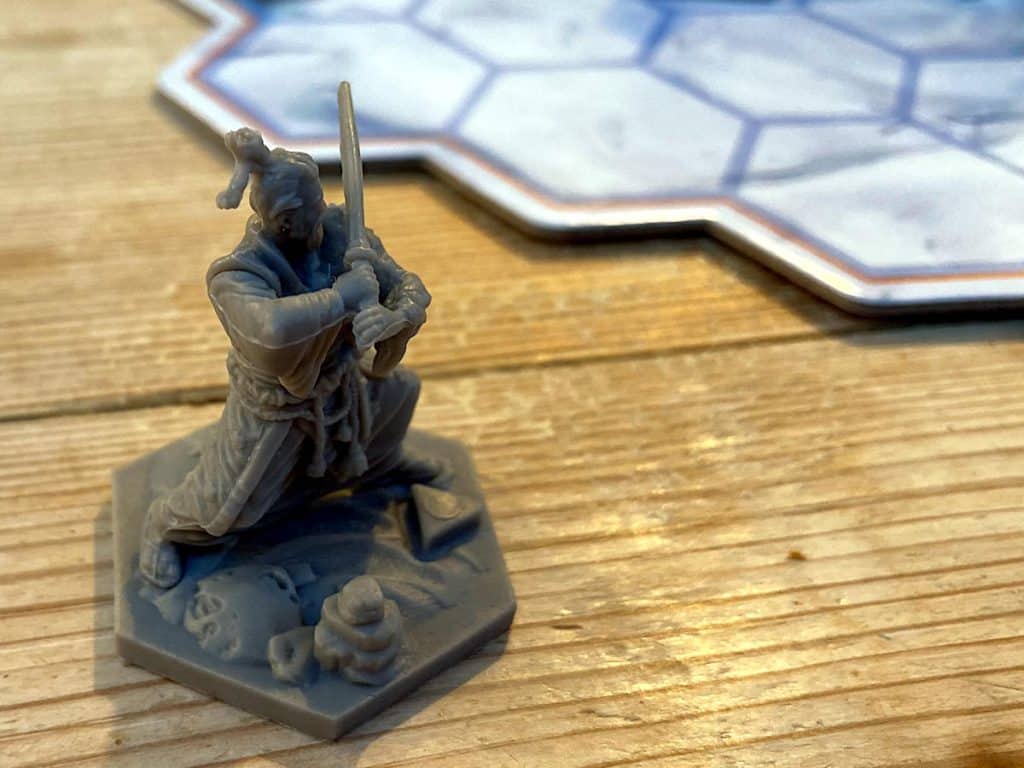
Spicy Battles
Yet, the fact that the game comes with terrain that blocks movement, that there are additional character sets offering more variety and that the battle arena can be set up however you want, is great, but it’s only a minor footnote in history compared to the amazing excitement that comes out of the card play.
That’s what makes Senjutsu: Battle for Japan such an exciting and interesting game. Playing the right card, with the right initiative, at the right time feels amazing. Second-guessing what other players are planning and taking advantage of that with a clever block or a devastating attack makes you feel like a battle-hardened samurai. You know you’re in your zen state when you can control your Kamae in such a way as to make the next card you play especially effective and powerful.
The only thing that taints the game for me is the setting. We have seen plenty of games set in Japan, featuring samurai or ninjas, designed by people who know very little about the actual history and who don’t seem to be interested in respecting what actually happened or the culture that comes out of it. Now, I don’t know if the game had the benefit of cultural advisors, but personally, it doesn’t feel like it has. I might be wrong, of course.
I think it’s time to bury our stereotypically Western views of the Far East and stop applying our romantically blinkered perspectives to a vast and ancient culture. Let’s make games that are authentic and involve people who have first-hand experience of the themes and settings. So while I don’t say Warhammer: Underworlds is culturally unproblematic, a fantasy setting would have suited Senjutsu: Battle for Japan a lot better in my view.
CORRECTION: People have pointed out to me that the publisher has used a cultural consultant on this game. The Kickstarter page for the game confirms this: “Special thanks go to our fantastic cultural representatives who are providing expert knowledge on Martial Arts, historical customs, the Japanese Language and cultural makeup of the Japanese people.”
This blog is free for everyone, but if you'd like to support it, here are some options.
Useful Links
- Senjutsu: Battle for Japan: https://luckyduckgames.
com/ en/ games/ 457-senjutsu-battle-for-japan - Rulebook: https://cdn.
1j1ju. com/ medias/ 42/ 0d/ 4a-senjutsu-battle-for-japan-rulebook. pdf - FAQs: https://www.
stoneswordgames. com/ _ files/ ugd/ 3cf294_ abce73a0327e4b03b59dd84f1c0897b0. pdf - Lucky Duck Games: https://luckyduckgames.
com/ en - BGG listing: https://boardgamegeek.
com/ boardgame/ 343900/ senjutsu-battle-for-japan - Games Workshop: https://www.
warhammer. com/ en-GB/ home - Warhammer Underworlds: https://www.
warhammer. com/ en-GB/ WarhammerUnderworlds-AoS-OtherGames-FLP
Videos
Transparency Facts
I feel that this review reflects my own, independent and honest opinion, but the facts below allow you to decide whether you think that I was influenced in any way. Please also read my Ethics Statement for more information.- I was given a free review copy of this game by the publisher.
- At the time of writing, I have not received financial support from the publisher or anyone working on their behalf.
Audio Version
Intro Music: Bomber (Sting) by Riot (https://www.
Music by Bensound
License code: XEIX6AY2E5AOGZOR
Music: “Legend” by AShamaluevMusic.
Website: https://www.
Playlist
These are the songs I listened to while I was writing this review:



